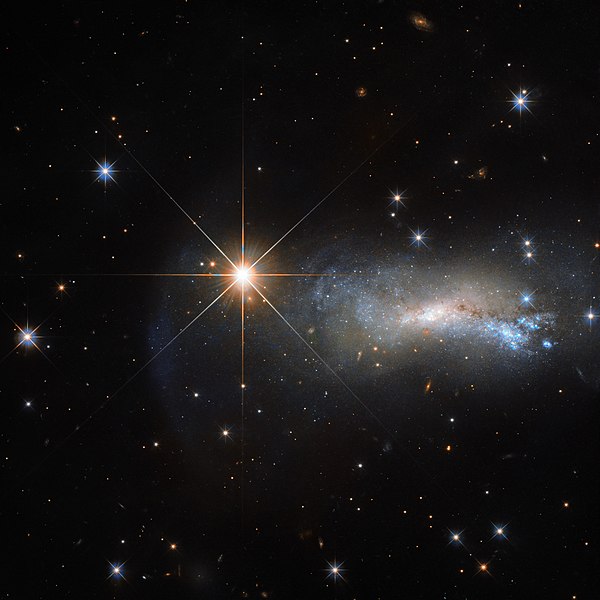File:Star from the Lizard Constellation Photobombs Hubble Observation (34280711966).jpg

Original file (4,104 × 4,104 pixels, file size: 3.99 MB, MIME type: image/jpeg)
Captions
Captions
Summary edit
| DescriptionStar from the Lizard Constellation Photobombs Hubble Observation (34280711966).jpg |
In space, being outshone is an occupational hazard. This NASA/ESA Hubble Space Telescope image captures a galaxy named NGC 7250. Despite being remarkable in its own right — it has bright bursts of star formation and recorded supernova explosions— it blends into the background somewhat thanks to the gloriously bright star hogging the limelight next to it. The bright object seen in this Hubble image is a single and little-studied star named TYC 3203-450-1, located in the constellation of Lacerta (The Lizard). The star is much closer than the much more distant galaxy. Only this way can a normal star outshine an entire galaxy, consisting of billions of stars. Astronomers studying distant objects call these stars “foreground stars” and they are often not very happy about them, as their bright light is contaminating the faint light from the more distant and interesting objects they actually want to study. In this case, TYC 3203-450-1 is million times closer than NGC 7250, which lies more than 45 million light-years away from us. If the star were the same distance from us as NGC 7250, it would hardly be visible in this image. Credit: ESA/Hubble & NASA NASA Goddard Space Flight Center enables NASA’s mission through four scientific endeavors: Earth Science, Heliophysics, Solar System Exploration, and Astrophysics. Goddard plays a leading role in NASA’s accomplishments by contributing compelling scientific knowledge to advance the Agency’s mission. Follow us on Twitter Like us on Facebook Find us on <a href="http://instagrid.me/nasagoddard/?vm=grid" rel="nofollow">Instagram</a> |
| Date | |
| Source | Star from the Lizard Constellation Photobombs Hubble Observation |
| Author | NASA Goddard Space Flight Center from Greenbelt, MD, USA |
Licensing edit
- You are free:
- to share – to copy, distribute and transmit the work
- to remix – to adapt the work
- Under the following conditions:
- attribution – You must give appropriate credit, provide a link to the license, and indicate if changes were made. You may do so in any reasonable manner, but not in any way that suggests the licensor endorses you or your use.
| This image was originally posted to Flickr by NASA Goddard Photo and Video at https://flickr.com/photos/24662369@N07/34280711966. It was reviewed on 12 May 2018 by FlickreviewR 2 and was confirmed to be licensed under the terms of the cc-by-2.0. |
12 May 2018
| Public domainPublic domainfalsefalse |
| This file is in the public domain in the United States because it was solely created by NASA. NASA copyright policy states that "NASA material is not protected by copyright unless noted". (See Template:PD-USGov, NASA copyright policy page or JPL Image Use Policy.) |  | |
 |
Warnings:
|
File history
Click on a date/time to view the file as it appeared at that time.
| Date/Time | Thumbnail | Dimensions | User | Comment | |
|---|---|---|---|---|---|
| current | 23:57, 11 May 2018 |  | 4,104 × 4,104 (3.99 MB) | OceanAtoll (talk | contribs) | Transferred from Flickr via #flickr2commons |
You cannot overwrite this file.
File usage on Commons
The following page uses this file:
Metadata
This file contains additional information such as Exif metadata which may have been added by the digital camera, scanner, or software program used to create or digitize it. If the file has been modified from its original state, some details such as the timestamp may not fully reflect those of the original file. The timestamp is only as accurate as the clock in the camera, and it may be completely wrong.
| Credit/Provider | ESA/Hubble & NASA |
|---|---|
| Source | ESA/Hubble |
| Short title |
|
| Image title |
|
| Usage terms |
|
| Date and time of data generation | 06:00, 24 April 2017 |
| Software used | Adobe Photoshop CC 2015 (Windows) |
| File change date and time | 17:42, 26 November 2016 |
| Date and time of digitizing | 00:23, 12 October 2016 |
| Date metadata was last modified | 18:42, 26 November 2016 |
| Unique ID of original document | xmp.did:acab4788-daca-924d-ae3d-ee9db82ff735 |
| Keywords |
|
| Contact information |
Karl-Schwarzschild-Strasse 2 Garching bei München, , D-85748 Germany |
| IIM version | 4 |